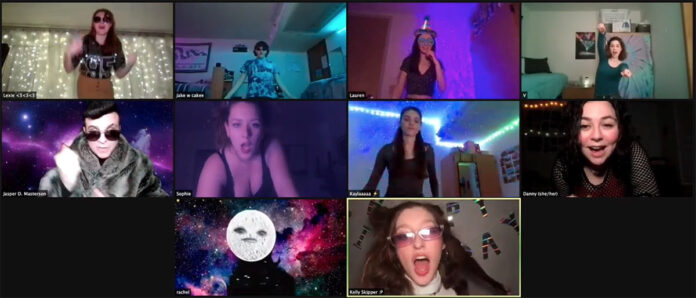
Muhlenberg’s department of theatre and dance’s Mnemonic Theatre Festival premiered its newest production this past week. “Unstable Connections” was co-conceived by theatre department professors Beth Schachter and Gertjan Houben, who also serve as director and engineer/editor respectively. The play has three episodes. The production was pre-recorded on Zoom, and each new episode is released to stream weekly on Thursdays. Only the first episode, “To Learn,” is currently streaming, but the other two episodes, “To Play” and “To Zoom” will have premiered by the end of the month.
This first episode of “Unstable Connections” featured a series of vignettes that highlight different experiences over Zoom. The scenes seem separate at first, but by the end, it is clear that many of the characters the audience has seen separately all actually know each other. And,they are using Zoom to attempt to connect with each other. The episode was humorous and enjoyable, largely because of the way it directly reflects our current reality of a virtual world. In addition, the performances and dialogue felt realistic and conversational which were key in helping the audience engage with the piece.. This relatability was intentional, as cast member Evan Schultz ’21 explained, “We’ve all been putting in a lot of our own personal experiences from Zoom into this, especially in the first episode.”
“Unstable Connections” truly feels like an ensemble piece, with every member of the cast contributing to the atmosphere and humor. eIn addition to Schultz, the cast includes Helena Bryant ’21, Gianna Carnevalino ’23, Julia De Vita ’23, Jill Friedland ’21, Emily Kitchin ’21, Gabriel Liron ’24, Fiona McGrath ’22, Luke Poleway ’22 and Ali Rohrbaugh ’22. The connection between the cast was incredibly clear—despite the Zoom environment—which made the relationships between the characters, feel even more real to the audience. The whole piece centers around the characters’ attempts to make and maintain connections with each other in a virtual environment, and a large part of the success of the piece was from the authenticity of the performances and the relationships the actors had with each other.
A lot of the process came from improvisational work from the cast, especially work in smaller breakout rooms. The improvisations would be prompted by the director or other members of the creative team. Schultz added that “The actors would work together to come up with fun, unique improvs and bring them back to the main room. We would show them to each other and pull things from them that we thought would work for the show.” Big ideas would be written down and throughout the rehearsal process, the different scenes and ideas would be melded and devised together to create the episodes of “Unstable Connections.” As a piece of devised theatre, the play has no formal script, instead being drawn entirely from the ideas of the cast and creative team. Instead, the cast just worked on a document with ideas of key moments that they wanted to make sure they worked into the piece. “We just sort of created it out of nothing, which was really cool. It was a lot of playing, and a lot of creating different characters, situations, a lot of relationships between characters, and conflicts.”
For the second and third episodes, the cast still worked largely from the same base of improvising and devising in breakout rooms, but they had to work with some new aspects as well. For the third episode, “To Zoom,” “Unstable Connections” plays around more with the confinement of a Zoom frame and how to use the limited space by manipulating camera angles and using certain aspects of Zoom. The cast members play different characters in each episode, with each one having their own set of stories and relationships.
If the second and third episodes of “Unstable Connections” are anything like the first, then they will certainly provide the audience with a humorous yet meaningful experience that they can look forward to. Despite the separation between each episode, Schultz, the other cast members and the creative team have found the connections between them as well, “They’re all about how technology is bringing people together in ways that we wouldn’t think possible otherwise. […] In each episode, we explore the possibilities of technology and appreciating and finding the light and diving into our current reality and laughing in the face of it, […] rather than having that fear that is associated with everything that is going on in the world.”





















